Myofunctional therapy is a set of physical therapy exercise that focused on:
Most of the time, adult behaviors can be traced back to habits formed in childhood. Specifically, training the muscles in the face to act in their optimal biological way can eliminate the need for future orthodontics. The muscle memory created by these exercises can keep the teeth and jaw in alignment as one grows and develops.
Orofacial Myofunctional Disorders (OMDs) primarily affect the functions and muscles of the mouth and face, causing a variety of effects via direct or indirect means. These effects include, but are not limited to: problems with breastfeeding, stunted facial skeletal growth and development, disordered chewing and swallowing, speech impediments, malocclusion, temporomandibular joint movement/disorders, poor oral hygiene, stability of orthodontic treatment, and facial esthetics. Many people mouth breathe more than they should. As a result, the muscles and the orofacial functions tend to adapt to a disordered breathing pattern, which in turn creates many OMDs.
Everything from eating to sleeping more soundly can be improved by myofunctional therapy. Of course, this is not mentioning how cosmetic benefits can bolster one’s self-esteem.
Myofunctional therapy helps by training the soft tissues of the face, neck, and mouth to function at the height of their ability, just like how physical therapy trains injured bodies back into their optimal shape. Myofunctional therapy is also complementary to numerous orofacial surgeries such as frenuloplasties and mandibular advancements. In developing your own personal myofunctional therapy regimen, we hope to cultivate in you an awareness of your orofacial muscle use.
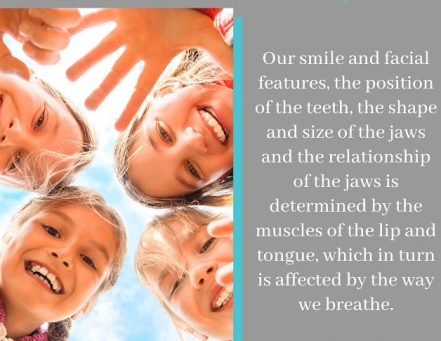
Specifically, we want to help to establish proper tongue position, lip sealing, and continuous nasal breathing. For instance, a low tongue position (not at the roof of the mouth) can contribute to improper muscle functioning and can lead to airway obstruction. We also feel it is necessary to clearly identify and illustrate the importance of pre/post operative myofunctional therapy exercises in a clinical setting and as part of a successful tongue-tie (Frenuloplasty) procedure. The ultimate goal of our program is to help strengthen the tongue and orofacial muscles through myofunctional therapy exercises and pattern retraining. We are confident this will resolve issues associated with sleep, breathing, posture, orthodontic relapse, cervical neck tension, and jaw pain, among others.
People with trouble speaking clearly, problems swallowing, or muscle weakness of the mouth may benefit from this treatment plan, as it will help the strength and the range of motion for your jaw, cheeks, lip and tongue.
Orofacial myofunctional therapy is also important for adults, and is commonly beneficial in this population. Myofunctional disorders can develop in response to reasons ranging from late jaw growth, worsening of a malocclusion over time, to tooth loss, and myofunctional therapy can deliver successes in treating these disorders.
Current literature demonstrates that myofunctional therapy decreases apnea-hypopnea index by approximately 50% in adults and 62% in children. Lowest oxygen saturations, snoring, and sleepiness outcomes improve in adults.
As an attractive alternative treatment for sleep apnea, myofunctional therapy is a clear candidate, since it is non-invasive, inexpensive, and has no major risks. It comes with beneficial effects on oral appliance therapy for obstructive sleep apnea and it complies with CPAP machines .
Myofunctional therapy may benefit those who suffer from a variety of ailments
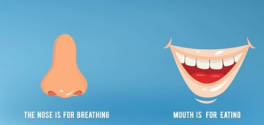
The most visually apparent effect of mouth breathing is altering how your child looks via their skeletal development. It also completely disrupts airway development, a process which in turn affects the amount of oxygen the body requires for proper function. It is known that mouth breathing influences the resting position of the facial and tongue muscles, so mouth breathers often experience a wide variety of signs and symptoms from early development to consequences later in life. Unfortunately, the failure to breathe through one’s nose affects one’s overall health. Mouth breathing plays havoc with the levels of oxygen and carbon dioxide in the body. For health, our bodies depend on a specific amount of incoming oxygen and outgoing carbon dioxide. Also, mouth breathing can make the lips and mouth dry from the loss of humidity. After all, the nasal passage warms, filters, and humidifies air, and mouth breathing forces air to avoid it altogether. This intake of cold, unfiltered air can induce one to dry mouths, coughs, frequent colds and undeniably affected dental health and maxillofacial development.
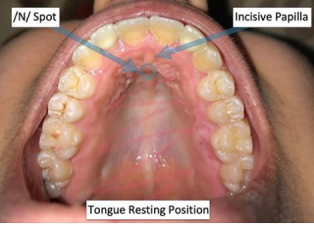
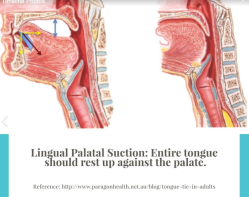
A low tongue rest position/posture can either be a necessity or a habit. Nevertheless, it can contribute to improper muscle functioning and even lead to airway obstruction.
During any time while the nasal breathing is impaired, temporarily or chronically, the jaw drops and the tongue positions itself low and forward in order to open up the upper airways.
The habit of a low tongue rest posture habit can last even if the reason for it has vanished, i.e. the tongue tie has been released or proper nasal breathing has been established. An additional benefit of myofunctional therapy is correcting the tongue resting position. Successful treatment can create better habits for lifelong better health.
A lack of nasal breathing or sleep disordered breathing may result in the tongue moving or being static, i.e. it resting forward and pushing against the teeth. 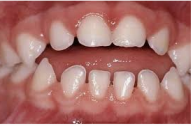
During the swallow, instead of pushing up to the palate the tongue becomes dynamic. It moves forward or laterally, a motion which can be called an anterior, bi-lateral, unilateral or bi-maxillary tongue thrust. 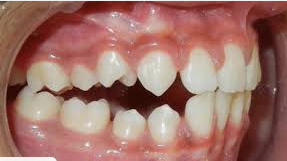
For the facial growth and airway development of children, it is crucial that a good resting tongue position is solidified.
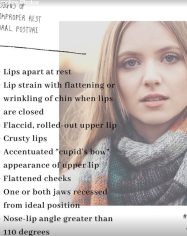
Lips apart at rest
Lip strain with flattening or wrinkling of chin when lips are closed
Flaccid, rolled-out upper lip
Crusty lips
Accentuated “cupid’s bow” appearance of upper lip
Flattened cheeks
One or both jaws recessed from ideal position
Nose-lip angle greater than 110 degrees
POOR ORAL HABITS RESTRICTING PROPER GROWTH & DEVELOPMENT
BOTTLE FEEDING
TONGUE THRUSTING
MOUTH BREATHING
PICKY/MESSY EATING
DROOLING
POOR POSTURE
LEANING ON CHIN
THUMB SUCKING
NAIL BITING
LIP BITING
HAIR CHEWING
PENCIL CHEWING
CHOKING/GAGGING
ABNORMAL POSTURE
GRINDING/CLENCHING
PACIFIER
The ultimate purpose of myofunctional therapy is to retrain the muscles and to obtain a normal resting posture of the tongue, lips and jaw. In particular, to facilitate proper nasal/diaphragm breathing, this therapeutic approach emphasizes correcting resting postures of the tongue and lips through training. It promotes the nose’s primary function in the body: inhaling oxygen, filtering air, and then warming and moisturizing it. This vital duty allows the body to get more usable oxygen, which is essential to the growth and development of the face and airway.
Benefits
Increasing the tone and mobility of oral structures which can be damaged in apneic patients
Correct use of oral structures i.e. the tongue, lip and cheek muscles will help breathing, swallowing, suction and chewing
References
Myofunctional Therapy to Treat Obstructive Sleep Apnea: A Systematic Review and Meta-analysis.
Camacho M, Certal V, Abdullatif J, Zaghi S, Ruoff CM, Capasso R, Kushida CA.
Myofunctional therapy improves adherence to continuous positive airway pressure treatment.
Diaféria G, Santos-Silva R, Truksinas E, Haddad FLM, Santos R, Bommarito S, Gregório LC, Tufik S, Bittencourt L.
Relapse of anterior open bites treated with orthodontic appliances with and without orofacial myofunctional therapy.
Smithpeter J, Covell D Jr.